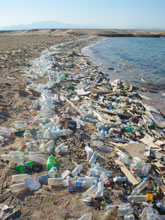
Mass extinction is the worst scenario our oceans could be facing if the tonnes of infiltrating plastic wastes will continue to build up and left unmanaged, according to a new report conducted by international researchers, and which estimates how much plastic debris ends up in the oceans.
This latest study has put figures to how much plastics are entering the ocean from waste generated on land. By linking worldwide data on solid waste, population density, and economic status, the researchers estimated the mass of land-based plastic waste entering the ocean.
Based on findings, around eight million metric tonnes (MT) of plastic wastes enter the oceans annually. The amount is predicted to continue to increase over the next decade unless measures to properly disposal plastic litter are taken up.
According to Jenna Jambeck, an assistant professor of environmental engineering at the University of Georgia (UGA) and lead author of the study, the heap of plastics that entered the oceans in 2010 (A previous estimate showed that some 275 MT of plastic waste was generated in 192 coastal countries in that year), range from 4.8 million to 12.7 million MT.
She said that the paper’s middle figure of eight millionis the equivalent of “five plastic grocery bags filled with plastic for every foot of coastline in the world”. The projection would likely double, that is, increasing to 10 bags per foot of coastline, by year 2025.
According to the researchers, population size and the quality of waste management systems largely determine which countries contribute the greatest mass of uncaptured waste available to become plastic marine debris.
The research lists the world’s 20 worst plastic polluters, from China to the US, based on such factors as size of coastal population and national plastic production.
As per the estimate, China ranks first, producing as much as 3.5 million MT of marine debris each year, whereas, the US, which generates as much as 110,000 MT of marine debris a year, is on the 20th spot.
While in terms of wastes being produced, US generates twice as much as China: Americans generate 2.6 kg of waste per person per day, while China generates only 1.10kg, yet the former has more efficient waste management, Jambeck said.
What can be done?
With the increasing levels of marine debris regardless of the clean-up measures being done in many countries, it could only mean that this measure is not adequate as it is also impractical. Once plastics are already in the oceans, only a portion of the bulk of debris floats, while most disappears, and presumably what does not wash ashore settles to the bottom, says the study.
On the other hand, collection systems that are fine enough to capture the smaller particles would also pick up enormous amounts of marine life. The researchers therefore suggest that improving waste management on land is the best option, adding that without waste management infrastructure improvements, the cumulative quantity of plastic waste available to enter the ocean from land is predicted to increase by an order of magnitude by 2025.
This suggestion may not be easily taken up as a priority especially among developing countries, said the researchers, adding that prioritising spending on critical infrastructure such as potable water, limits spending for waste management.
(PRA)































